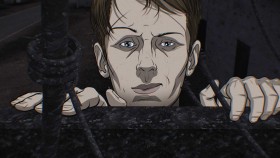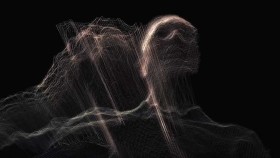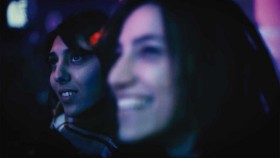Allerede i 1980’erne, da jeg rejste rundt i ind- og udland for Statens Filmcentral, var mit standardsvar på, hvem der er de betydeligste danske dokumentarister, Jørgen Leth, Jon Bang Carlsen og Anne Wivel – den trio, som dansk dokumentarismes aktuelle succes hviler på. Jeg klikker ind på Det Danske Filminstituts filmdatabase og ser den lange, lange liste over Annes film som instruktør, producer, konsulent, manuskriptforfatter. Filmografien kan ses som et katalog over dokumentarfilmens store udtryksmæssige spændvidde. “Gorilla, gorilla”, “Den lille pige med skøjterne” og “Vand”, alle fra 80’erne, er tavse, iagttagende kortfilm, fine små poetiske perler, hvorimod der snakkes uafladeligt i vérité-filmene “De tavse piger”, “Motivation” og “Ansigt til ansigt”. Sidstnævnte er 165 minutter lang (!), optaget på 16mm på Pastoralseminariet, et hovedværk i dansk film, inspireret af amerikanske Frederick Wiseman, men med sin helt egen tone og enkelhed… (Tue Steen Müller)
Anne Wivels ”Mand falder”var åbningsfilm på CPH:DOX og nu i disse dage viser DOXBIO filmen i en lang række biografer. Det er anledningen til her at samle, hvad vi på Filmkommentaren har skrevet om instruktøren og nogle få af hendes mange film.
GISELLE (1990)
Den gamle danser står i øvesalen. Billedet viser ham lige forfra, han danser for kameraet. En komisk-yndefuld dans henvendt til filmen. Klaveret akkompagnerer. Kameraets eneste bevægelse er den forbudte zoom fra total ind i tæt på nær. Ganske langsomt. Jeg ser dansen til ende. Han fortæller jo en historie, som ikke kan afbrydes. Det er en inklination, en opfordring, en henvendelse.
Denne første scene er minutlang. Sådan er overenskomsten. Det her kommer til at tage lang tid. Og der klippes til en krantur, teatrets dekorerede loft afsøges i den bløde svimle bevægelse. Her er den verden, jeg indbydes til. Teatrets lyde, en sanger varmer op, billedet strejfer prismekroner og portrætter af skuespillere. Ved titelskiltet svinder al lyd. Kun det ene ord og en svag spinkel tone, a – forestillingen kan begynde.
To mænd i profil. En lidt ældre, en lidt yngre. Næsten i filmens sorthvide mørke. En lampe tegner netop deres profil. De ser på finalen. Nede på scenen. Vi er allerede ved slutningen. Hun ligger livløs på scenens gulv. Stemmen – den mørke, kompetente mandsstemme siger: ”… og hendes sind bristede, og hun blev vanvittig, og hun døde.”
Heidi Ryum rejser sig med et suk af anstrengelsen. De går omkring på scenen og snakker om forestillingens detaljer, jeg genkender den indre stemme, ser hvem han er. Balletmesteren, som fortæller mig om dette sværeste af alt, kærligheden. Spændet i alder mellem danseren og balletmesteren lover mig, at fryden og smerten fortsætter filmen igennem, livet ud.
Og stemmen fortsætter i øvesalen, dens blik og mit blik følger hendes fødder, først nær, så ser jeg hende slide med opgaven, og stemmen forlanger kontrol, og hun danser som et venligt svar passagen igen. ”Kunne du mærke det, Heidi?” spørger han. Det er helt konkret dokumentarfilm det her, og i næste billede sidder han i sin træthed ved bordet, og hans mikroport registrerer: ”Kærlighed…”, siger han til sig selv, og intet vil jeg hellere end høre resten af sætningen. Blive ved den film… (ABN)
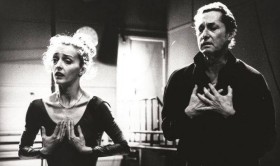
SLOTTET I ITALIEN (2000)
Jeg glæder mig rigtig meget til Anne Wivels nye film med Per Kirkeby, Mand falder, som får premiere i DoxBio til november. Som forberedelse ser jeg Slottet i Italien fra 2000. Det er her også Per Kirkeby, som spiller den store rolle som manden midt i livet, manden i krise. Som spiller rollen som sig selv.
Den handler også om Anne Wivel og hendes filmkunst. I et interview engang sagde hun ”… Jeg ønsker at filme disse konflikter. Jeg synes ikke en konflikt er en privat ting, den kan deles med alle og enhver. Når jeg har fået de medvirkendes accept, er de altid meget villige, givende og åbne…” Og så fortæller hun om Giselle (1991), hvor balletmesteren Henning Kronstam kommer i en konflikt, som på mange måder minder om Per Kirkebys. Det er Anne Wivel, som i sin instruktion og med sit greb tilvejebringer disse usædvanlige dybder af forståelse, som måske også kommer bag på de to mænd.
Nu skildringen af maleren i det italienske slot. Lyden begynder før billedet. Det er fuglestemmer. Så ser vi malet murværk, brækkede nuancer i rødt og grønt. Og væggen har tydelige og betydningsfulde revner.
Og så pjattet mandesnak. De to mænd sidder og ler i et stort rum. Maleren og hans gæst. Instruktørens stemme høres, så vi fra nu ved, at hun også er til stede. Kvinden med kameraet hedder hun på forteksten. Man taler lettere, når man ved, det ikke skal bruges, det man siger, bemærker de to mænd, sikre på, at dette er en prøve. Og så kommer tavsheden, som den vigtige pause i dialogen, men ikke pause i filmens fortælling. Gæstens næste bemærkning er: ”Det skide kamera ser mere, end vi ser”. Kameraet afsøger nu loftet.
Så sidder maleren vrissen på briksen og siger, at indfald ikke kan gentages. Igen er han tavs. Tøver og siger, at han er forkølet og forvirret. Dagbogen er opgivet for første gang i 30 år. I tre årtier til nu har han bogført sit liv. Billedet viser, at bladene udenfor bevæger sig voldsomt i blæsten. Oliventræet vender den grå underside opad. De taler om farverne, som maleren altid vil bryde ned. Farver skal være præcise, ikke brilliante.
Så fortæller han om Vibeke. ”For dem, som stiger på romanen nu, så er hun min kone”, siger han. Og han fortæller om den skæbnesvangre begivenhed. Som har med huset, slottet, stedet og hende at gøre. Det handler altså om det gamle hus og rummene. Om to mænd og en kvinde, som filmer maleren og gæsten, hvis emner i hvert fald er seksualiteten og kønnet. Og arbejdet og tilstanden nu. Og om samværet dette sted. Som er kvindens sted og kærlighedens, måske.
Spørgsmålet stiller maleren til instruktøren: ”Er det sådan, det skal være? Alt det her pladder?” Hun svarer off: ”Jah…”, altså både ja og nej. Så fortæller maleren en anekdote fra Alma Mahlers selvbiografi. Da han er syg til sidst siger hun til ham, at når han bliver rask, skal de gå fra den åndelige kærlighed til den lidenskabelige. De skal begynde at røre ved hinanden, fortæller maleren. Jeg stiger på romanen her…
Danmark 2000, 95 min. Slottet i Italien kan streames på bibliotekernes FILMSTRIBEN: http://www.filmstriben.dk/bibliotek/film/details.aspx?filmid=2334400900 (ABN, blogindlæg 17. juni 2015)
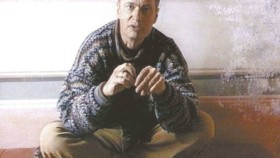
MENNESKENES LAND (2006)
Filminstituttets nye smukke, velordnede, velfungerende og gratis streamingtjeneste FILMCENTRALEN / FOR ALLE foreslår i sit nyhedsbrev i går, at man ved siden af fodboldfilm skal se film om grønlandske emner: ”Grønland-før og nu. Storslået natur og barske levevilkår – det er to gennemgående elementer i denne samling af film om Grønland. Filmene er lavet i perioen 1955-2013 og handler både om hverdagsliv, ekspeditioner og særlige begivenheder”, hedder det, og jeg kigger listen med de udvalgte titler igennem, og vil anbefale Anne Regitze Wivels Menneskenes land (2006), som jeg holder så meget af. Den handler om et punkts position. Ja, den gør…
Jeg husker endnu fra min tid på filminstituttet den allerførste formulering af filmens synopsis: ”Jeg tror, der mangler en film om Grønland, dette store hvide sted som er skæbneforbundet med Danmark. Alle danskere, der har været i Grønland, har siden et punkt i hjertet, der er helt blødt. Sådan også med mig, der har rejst deroppe to somre for længe siden. Grundstemningen i den film, jeg ser for mig, er det bløde punkts position. Hvor øvelsen går ud på at lade sig rive med, snarere end rationelt at holde igen.”
Instruktøren meddelte altså, at hun gerne ville lave en film om Grønland. Så uoverskuelig som landet og så enkel som sætningen. På én gang. Og det stod med det samme klart for mig: ja, naturligvis. Som en selvfølge næsten. Før jeg hørte begrundelserne, før jeg læste oplægget.
Det var fordi Jette Bang ikke er mere, fordi også Jørgen Roos er død. Og tiden en anden, ikke bedre, men heller ikke ringere. Der var altså stadigvæk filmfolk med kærlighed til virkeligheden bag det smukke navn for landet. Folk med nervøsitet og indsigt og poetisk holdning. Som kunne fortsætte arbejdet med at lave film i den tradition. Som er blevet vores forpligtelse, fordi det land har en vigtig del af vores skæbne knyttet til sig. Der er altså for eksempel Anne Wivel. Jeg bildte mig ind at vide, hvor det her ville bevæge sig hen.
Jeg oplever, Anne Wivels store film hver for sig i deres kerne handler om et omfattende væsen , som hun tager til filosofisk og poetisk behandling: troens væsen, kunstens væsen, tankens væsen. De har hver deres afsides sted: præsteseminarets samtale (Ansigt til ansigt, 1987), balletmesterens indre monolog om kærlighedens forvandlingsformer (Giselle, 1990) og endelig den store digters tekster (Søren Kierkegaard, 1994).
Her kunne det så ske, hun føjede politikkens væsen til. Stedet ville blive den politiske vilje, som den udfolder sig i Nuuk. Men filmen ville også komme til at handle om det grønlandske landskab. Landets mørke og lys. Om et bestemt punkt, som kun Anne Wivel kan skildre på den måde: “alle danskere, der har været i Grønland, har siden et punkt i hjertet, der er helt blødt…” Anne Wivel ville med det her være på vej til en ny stor film. Som ved siden af sin poetiske erkendelse tillige ville blive en omfattende dokumentarisk skildring af det nye Grønland og dets magtelite. På godt og ondt, men mest på godt, forestillede jeg mig.
Filmen var længe undervejs, mange ideer måtte sikkert forlades, nye muligheder kom bestemt til. Den havde premiere februar 2006. Den var helt anderledes, end jeg havde forestillet mig, men det bløde punkt var bestemt positioneret og skildret. Jeg holder meget af den film. Danmark, 2006, 81 min. (ABN, 18. juni 2014)
http://filmcentralen.dk/alle/film/menneskenes-land-min-film-om-groenland
http://filmcentralen.dk/alle/tema/groenland-foer-og-nuutm_campaign=&utm_medium=Alle&utm_source=Newsletter
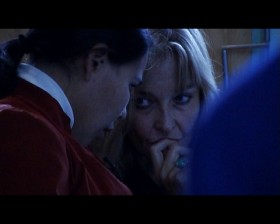
SVEND (2011)
This is a review in Danish language of a new documentary made by Anne Wivel, acclaimed veteran in Danish documentary. For years she followed her husband, politician Svend Auken in his work in- and outside Denmark. Auken, a strongly committed humanist, suffered from a cancer illness but was active until his death in August 2009. The film, that premieres this month, is brilliant.
Udgangspunktet er jo klart fra start. Dette er en film om en mand, som er død. En dansk politikers sidste år, ”filmet og erindret af Anne Wivel”, som skrevet står på lærredet i filmens begyndelse. Anne Wivel som levede med Svend Auken i syv år, fra 2002 til hans død i august 2009. En hustru som filmer sin mand, som er syg af kræft, det kunne gå hen og blive flæbende, det er det ikke, slet slet ikke, det er tværtimod en bevægende og smuk erindring som instruktøren giver sit publikum, og på mange måder også en almenmenneskelig henvendelse, som efterlader én smilende glad over at have mødt et fint, kærligt menneske. Og forpustet for det var dog helt utroligt, hvad Svend Auken nåede af møder, taler og tv-medvirken. Og trist, naturligvis, over at det gik den vej, som det gik. Som han siger, jeg ville jo gerne leve lidt længere.
Svend Aukens engagement i klimapolitik, hans internationale betydning som medlem af diverse bestyrelser, hans retoriske begavelse og talent for at tale til store forsamlinger og gribe dem om hjertet, hvad enten han talte på dansk eller engelsk – er stærkt dokumenteret af Anne Wivel, som fulgte ham på mange rejser verden rundt. Men det er ikke derfor, at denne film om en mand, som var politiker, hæver sig højt over de mange andre politiker-film vi er blevet præsenteret for i de sidste år (Fogh, Khader, Lykketoft f.eks.). Grunden er den enkle, at her bringes vi i selskab med en politiker i sit hjem, i sit sommerhus, i en sommerlejlighed i det sydlige Frankrig, på et hotelværelse med himmelseng i Brønderslev! Med Anne Wivel bag kameraet, i årtier en af dansk dokumentarfilms stærkeste profiler som instruktør og producent.
Og det er jo derfor, at filmen hæver sig. Det er en film, det her, der er foretaget nogle valg ud fra et stort materiale, der er i klipningen fundet en rytme, hvor pauserne i det politiske ”udeliv” spiller en rolle, ind imellem de mange møder, hvor de mange små vidunderligt sigende og smukke dagligdagsøjeblikke træder frem og skaber tonen. Når Svend kommer hjem, står Anne for enden af trappen og filmer ham igen og igen. Man sidder faktisk undervejs og venter på at den scene skal gentage sig. Når Svend småsnakkende til kvinden bag kameraet spejler æg i det lille køkken og varmer mælk i mikroovnen. Det gør han mange gange i filmen. Når han starter en sætning, men ikke kan afslutte den, fordi han læser avis og ikke kan ”multi-taske”. Når han sidder i en stol med sit boardingkort i jakken, strandet i Ålborg lufthavn, maskinen går ikke pga. maskinfejl, så falder man med ham helt ned, stresser af og tager på hotel i Brønderslev. Eller når han bliver hamrende irriteret, fordi taxaen ikke kommer og han skal være i et tv-studie om et øjeblik, tingene skal klappe. Genkendelig hverdagsbeskrivelse.
Anne Wivel er bag kameraet, hun stiller spørgsmål til Svend, svarer når han spørger og beder om reaktioner til sine taler, hun er der hele tiden, men trænger sig ikke på, viser ikke hvor forfærdeligt, det må have været at filme sin mand blive mere og mere syg – for så i én sekvens, Villefranche i Sydfrankrig i januar 2009, at lade kameraets bevægelser skrive et digt om et dejligt rum med udsigt til vand, et rum med smukke ting, musik og stearinlys. Det emmer af kærlighed.
Danmark, 110 mins., Instruktør & fotograf: Anne Wivel, Klippere: Camilla Skousen og Peter Winther, Komponist: Povl Kristian. Med støtte fra DFI og DR. (Tue Steen Müller, blogindæg 5. september 2011)
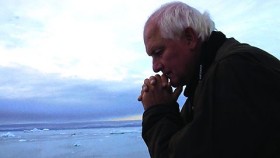
FØDSELSDAG 2015
Det Danske Filminstitut skriver i dag under overskriften “Anne Wivel – dansk dokumentarfilms mor”: FØDSELSDAG. Filminstruktør Anne Wivel fylder 70 år den 18. juni. FILMupdate har bedt to filmkolleger skrive en hilsen. De to er Mikala Krogh og Tue Steen Müller.
Mikala Krogh skriver: “Hvis jeg skal tænke på en scene, et enkelt øjeblik, der er summen af Anne Wivels samlede værker af dokumentarfilm, så er det scenen, hvor Heidi Ryom står sammenbøjet med hænderne på knæene, i kulissen af Det Kongelige Teaters gamle scene, efter sin kraftpræstation i Giselle. Lyset, skyggerne og framingen, det hele går op i en højere enhed, og som beskuer føler man sammen med solodanserinden både hendes udmattelse og glæde ved at have givet alt, hvad hun har i sig af kunstnerisk styrke og fysisk vilje. Det er et helt unikt øjeblik, Anne Wivel lader os være vidne til…” (Læs videre på FILMupdate, link forneden)
Tue Steen Müller skriver: “Allerede i 1980’erne, da jeg rejste rundt i ind- og udland for Statens Filmcentral, var mit standardsvar på, hvem der er de betydeligste danske dokumentarister, Jørgen Leth, Jon Bang Carlsen og Anne Wivel – den trio, som dansk dokumentarismes aktuelle succes hviler på.
Jeg klikker ind på Det Danske Filminstituts filmdatabase og ser den lange, lange liste over Annes film som instruktør, producer, konsulent, manuskriptforfatter. Filmografien kan ses som et katalog over dokumentarfilmens store udtryksmæssige spændvidde. Gorilla, gorilla, Den lille pige med skøjterne og Vand, alle fra 80’erne, er tavse, iagttagende kortfilm, fine små poetiske perler, hvorimod der snakkes uafladeligt i vérité-filmene De tavse piger, Motivation og Ansigt til ansigt. Sidstnævnte er 165 minutter lang (!), optaget på 16mm på Pastoralseminariet, et hovedværk i dansk film, inspireret af amerikanske Frederick Wiseman, men med sin helt egen tone og enkelhed…” Læs videre på FILMupdate:
http://www.dfi.dk/Nyheder/FILMupdate/2015/Juni/Anne-Wivel-dansk-dokumentarfilms-mor.aspx (ABN, blogindlæg 17. juni 2015)

MAND FALDER (2015)
Det begynder stille og roligt med Anne Wivels stemme, som nænsomt fra bag et fortæppe af Per Kirkeby lærreder ganske kort fortæller den personlige baggrund for filmen: Kirkeby er en forårsdag 2013 faldet ned ad en trappe, har fået en hjerneskade, som alvorligt forstyrrer hans syn og hans bevægelighed, han kan ikke male, han kan ikke gå. Hun kan omsider besøge ham og aftenen før ringer hans hustru og siger, at han gerne vil at Anne Wivel tager sit kamera med. Hun bevæges, hun har ikke brugt kameraet siden hendes mand to år tidligere faldt og slog hovedet og kort efter døde, og hendes dæmpede stemme fortsætter herefter med hendes ja, dette fortrolige og ægte ja til sætningerne fra maleren og vennen, fortsætter og fortsætter. Anne Wivel er i den her film til stede hele tiden, i optagelserne, i samværet som vokser til filmværket som Per Kirkeby vel sådan har ønsket de endnu en gang kunne lave sammen.
Titelsekvensen klipper til atelieret, Kirkeby sidder og taler med kameraet og lidt med sin hjælper som også er der, og lidt med hustruen som også er der, der er hele tiden mennesker omkring ham, og han taler med kameraet og med Anne Wivel bag det, taler om situationen: jeg kan ikke gå, jeg kan ikke male, jeg kan ikke se, jeg kan ikke genkende ansigter. Det er ærgerligt siger hun, det er godt nok surt siger han og så går de i gang med at lave filmen. Filmens kurve bliver som Kirkebys kurve, den må skabe et nulpunkt, tror jeg det er han siger, og så må den med ham bevæge sig frem gennem en række af stemninger, som bliver til filmens afsnit. Sådan aftaler de konstruktionen, så enkel er den, de to erfarne ved hvad de gør. ”Jeg magter det ikke helt, det ved jeg godt, det må være som det er,” udbryder han et sted i gang med et billede, et værk trods alt, og klaverkoncerten triumferer ved de kunstneriske sejre, ved indsigtens gennembrud.
Per Kirkeby tegner, Anne Wivel filmer. De arbejder sammen, nu ved farvetuberne og så er vi ved lærredet, ”jeg mister orienteringen”, siger han, og han kigger på lærredet, ”… det er som et tapet”. ”Du er hård, Per” siger hun. Sådan taler de med hinanden, mens de arbejder på værkerne, arbejder sig gennem scenerne, stemningerne. Med Minik Rosing på Louisiana, Kirkeby kan ikke huske, ”det er så mærkeligt ikke at kunne genkende sine egne billeder”, siger han. Så hjemme i villaen i Hellerup, træning i et få synet på plads igen. Samtalen med Anne Wivel er så enkel, så kortfattet, så fin: ”Er du ked af det?” ”Ja.” ”Det kan jeg godt forstå”. En anstrengende rejse til Aars til afsløring af en stor skulptur, en tilsvarende nøgtern samtale med dronning Margrethe. Hjemme i Hellerup igen, han modellerer i lille format. Alligevel: ”Jeg magter det ikke helt. Det ved jeg godt.” Og så befriende fast: ”Det må være som det er.” Samtalen med Anne Wivel kommer til at handle om tålmodighed og dovenskab. Han vil godt lære tålmodighed men kan ikke med dovenskab. Hun synes han skal give sig hen i den. Nye dybe indsigter kan det føre til. ”Dem er jeg ikke stødt på”, replicerer han tørt. Og så alligevel, jo, han er stødt på kærligheden og på evnen til at tilgive ”og sådan noget, det har aldrig været min stærke side”. Det virker måske banalt i mit referat, i filmen er det aldeles ægte og vigtigt og meget smukt. Og han taler spontant om hustruen og spørger om det ikke også var sådan med Svend, hendes mand? Og jeg lukkes som en generøsitet ind i et nyt rum.
Han tegner pludseligt energisk med et stykke oliekridt, han tegner faldet på trappen, tegner først trappen, ”en rigtig Kirkeby-trappe”, siger han og både Anne Wivels kamera og jeg kan se at det er det netop, se det langt tilbage i hans værk. Og han tegner med sikre, sikre bevægelser faldet og senere skrammerne og så det der neden for trappen. En tegning bliver til og koncertens orkesterstemme triumferer. Han tegner videre på et nyt ark og hun siger: ”Det er skønt, Per. Du skal blive ved…”
Der kommer nye afsnit, nye stemninger, nedture mod nulpunktet og flere og flere sejre, mange hos de trofaste kolleger i det grafiske værksted.
Anne Wivel har gemt en vældig overraskelse til sidst, jeg bliver bestemt overrasket og ved eftertanke på en måde ikke: jeg er igen med Anne Wivel og Per Kirkeby på slottet i Italien, igen på det sted efter 15 år og jeg er tryg. Landskabet i bjergene er der, den ærværdige kolossale bygning ligger der, de gamle fresker så åbenbart øget siden sidst med Kirkebys talrige nye sidder der på væggene. Vennerne og kollegerne er med, lærrederne står parat i atelieret. Men atelieret ligger øverst ved slutningen af en høj stenbygget trappe, en hel del vanskeligere at gå på end trappen til træning hos fysioterapeuten, også fysisk vanskeligere, men filmen handler om den anden vanskelighed, trappens begivenhed som motiv ”den rigtige kirkebyske trappe” og senere er motivetSebastian bundet til træet døende med de mange pile i kroppen, men jeg ved at en kvinde vil pleje hans mange sår og han vil komme sig. For en tid.
Som hos Platon er der indlagt taler i fremstillingen. Der er faktisk indlagt to. Jeg ser det bliver til tre. En tredjedel inde i filmen taler ved en fest på et galleri Hans Edvard Nørregård-Nielsen. Det er en tale om det danske og om to digtere, Thøger Larsen og Poul Martin Møller. I sin stemmes myndighed viser han digtlinjernes lighed med træk i Kirkebys malerkunst, lighed i en særlig danskhed og i en udødelighed. Ved en anden sammenkomst, det er i huset på Læsø, læser Peter Laugesen et digt og det er et digt om kunstnerisk størrelse og sindets vejrlig: ”… Det format, der kan rumme de drejende lavtryk, de dybe huller, hvorfra vindene kommer / de nedre og øvre passater, monsuner, kulinger, storme og orkaner. / Drømmenes skypumper.” Og Anne Wivel laver på en måde sin film som endnu en tale om at fremstille dyb, indsigtsfuld kunst i trodsigt mod på trods af, en hjernes skade.
Et tidsrum i Per Kirkebys liv hedder filmens undertitel på plakaten. Tidsrum… Det er et smukt ord det danske sprog aldrig må miste. Tidsrum, tid og rum, tid i rum, rum tid som betyder rummelig tid, omfangsrig tid, tilstrækkellig tid. Her er tid nok. Sådan er Anne Wivels nye films vigtige erkendelse af livet, menneskets liv. Uanset det tidsbundne i filmens biografiske udgangspunkt vil Anne Wivels Mand falder blive stående længe som umisteligt hovedværk i dansk film, endnu et hovedværk fra hendes hånd, endnu et værk om mandigheden og Eros’ stadige jagt på skønheden. Danmark 2015, 108 min. PREMIERE I AFTEN ved åbningen af CPH:DOX 2015. (ABN, blogindlæg 3. november 2015)




